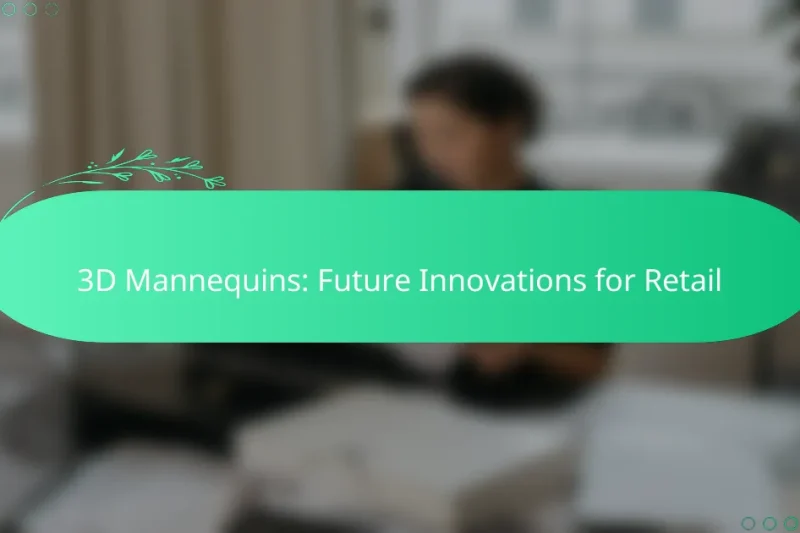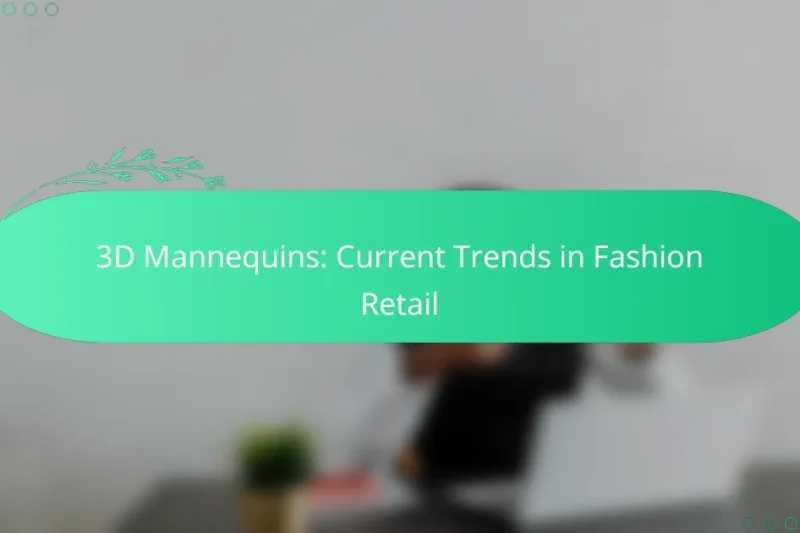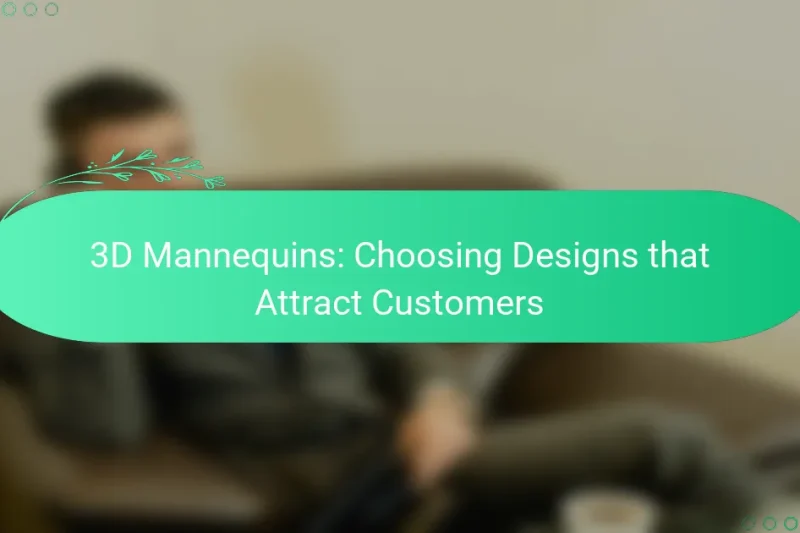3D mannequins are transforming the retail landscape by providing dynamic visual merchandising and immersive shopping experiences. … 3D Mannequins: Future Innovations for RetailRead more
3D Mannequin Design Trends
The latest trends in 3D mannequin design are transforming the retail landscape by prioritizing visual appeal and customer interaction. With advancements like hyper-realistic textures, dynamic poses, and augmented reality integration, these innovative displays create immersive shopping experiences that captivate consumers and drive sales.
3D Mannequins: User Preferences and Design Appeal
In the evolving landscape of retail, 3D mannequins play a crucial role in enhancing customer engagement … 3D Mannequins: User Preferences and Design AppealRead more
3D Mannequins: Current Trends in Fashion Retail
3D mannequins are transforming the fashion retail landscape by offering interactive and dynamic displays that significantly … 3D Mannequins: Current Trends in Fashion RetailRead more
3D Mannequins: Incorporating Cultural Trends in Designs
3D mannequins are revolutionizing the retail landscape by incorporating cultural trends that resonate with consumers. By … 3D Mannequins: Incorporating Cultural Trends in DesignsRead more
3D Mannequins: Choosing Designs that Attract Customers
Choosing the right 3D mannequins is crucial for attracting customers and enhancing their shopping experience. By … 3D Mannequins: Choosing Designs that Attract CustomersRead more
3D Mannequins: Seasonal Trends and Design Choices
As the retail landscape evolves, the latest seasonal trends in 3D mannequins highlight vibrant colors, innovative … 3D Mannequins: Seasonal Trends and Design ChoicesRead more
3D Mannequins vs. Modern Designs: Which Is Better and When to Use
In the world of retail, the choice between 3D mannequins and modern designs can significantly impact … 3D Mannequins vs. Modern Designs: Which Is Better and When to UseRead more
What are the latest 3D mannequin design trends in retail?
The latest 3D mannequin design trends in retail focus on enhancing visual appeal and customer engagement through innovative techniques. Retailers are increasingly adopting hyper-realistic textures, dynamic poses, eco-friendly materials, customizable features, and integration with augmented reality (AR) technology to create a more immersive shopping experience.
Hyper-realistic textures
Hyper-realistic textures are becoming a hallmark of modern 3D mannequin design, allowing for lifelike representations that attract customers. These textures mimic real skin, fabric, and hair, enhancing the overall aesthetic and making displays more engaging.
To achieve hyper-realism, designers often use advanced rendering techniques and high-resolution images. This trend not only improves visual appeal but also helps convey the quality of the clothing being displayed, making it easier for customers to envision how the garments will look on them.
Dynamic poses and expressions
Dynamic poses and expressions are essential for creating mannequins that capture attention and convey emotion. Retailers are moving away from static displays, opting for mannequins that showcase clothing in action, which can suggest movement and lifestyle.
Incorporating varied poses and facial expressions can significantly enhance storytelling in retail displays. For example, a mannequin in a playful pose can evoke a sense of fun, while a more relaxed stance can suggest comfort, helping customers connect with the brand’s message.
Eco-friendly materials
Eco-friendly materials are increasingly prioritized in 3D mannequin design as sustainability becomes a key concern for consumers. Retailers are exploring biodegradable plastics, recycled materials, and sustainable production methods to reduce their environmental impact.
Using eco-friendly materials not only aligns with consumer values but can also enhance brand reputation. Retailers can highlight their commitment to sustainability, which may influence purchasing decisions, especially among environmentally conscious shoppers.
Customizable features
Customizable features allow retailers to tailor mannequins to specific marketing campaigns or seasonal trends. This flexibility can include adjustable body parts, interchangeable accessories, and even color variations to match the brand’s identity.
Offering customizable mannequins can streamline inventory management and reduce costs. Retailers can adapt their displays quickly without needing to invest in entirely new mannequins, making it a practical solution for changing trends.
Integration with AR technology
Integration with AR technology is revolutionizing the way customers interact with 3D mannequins. Retailers are using AR to allow customers to visualize how clothing will look on them or in their environment, enhancing the shopping experience.
By incorporating AR, retailers can create interactive displays that engage customers more deeply. For instance, customers can use their smartphones to see how a garment fits on a virtual mannequin, bridging the gap between online and in-store shopping experiences.
How do 3D mannequins enhance customer engagement?
3D mannequins significantly enhance customer engagement by providing interactive and immersive shopping experiences. They allow customers to visualize products in a realistic context, which can lead to increased interest and higher conversion rates.
Interactive shopping experiences
3D mannequins create interactive shopping experiences by allowing customers to manipulate and view products from various angles. This interactivity can include rotating the mannequin, changing outfits, or even adjusting sizes, making the shopping process more engaging.
Retailers can implement touchscreens or mobile apps that enable customers to interact with the mannequins, enhancing their overall experience. This approach can lead to longer time spent in-store or on-site, ultimately increasing sales opportunities.
Personalized marketing opportunities
Using 3D mannequins allows retailers to offer personalized marketing opportunities tailored to individual customer preferences. By analyzing customer data, retailers can showcase specific products that align with a shopper’s style or past purchases, increasing the likelihood of conversion.
For example, a clothing store could use 3D mannequins to display outfits that match a customer’s previous selections, creating a customized shopping experience. This targeted approach can significantly improve customer satisfaction and loyalty.
Visual storytelling capabilities
3D mannequins enhance visual storytelling by allowing brands to convey their narratives through dynamic displays. Retailers can create themed environments or seasonal showcases that resonate with customers, making the shopping experience more memorable.
For instance, a sports apparel brand might use 3D mannequins to depict athletes in action, effectively communicating the brand’s values and lifestyle. This storytelling approach not only attracts attention but also fosters an emotional connection with the audience, encouraging them to engage with the brand further.
What are the benefits of using 3D mannequins over traditional mannequins?
3D mannequins offer several advantages over traditional mannequins, including cost savings, design versatility, and enhanced inventory management. These benefits make them an appealing choice for retailers looking to optimize their display strategies.
Cost-effectiveness in production
Using 3D mannequins can significantly reduce production costs compared to traditional models. They eliminate the need for physical materials and labor associated with creating and maintaining standard mannequins. This can lead to savings in the low thousands of dollars for retailers with large inventories.
Additionally, 3D mannequins can be easily modified and replicated, allowing businesses to create multiple designs without incurring high costs. This flexibility means that retailers can quickly adapt to changing fashion trends without a substantial financial burden.
Flexibility in design
3D mannequins provide unparalleled flexibility in design, allowing retailers to customize their displays to match specific themes or seasonal collections. Designers can easily alter colors, poses, and even body types to create a more engaging shopping experience.
This adaptability enables brands to showcase their products in a way that resonates with their target audience. For instance, a clothing store can create a series of mannequins that reflect diverse body shapes, promoting inclusivity and appealing to a broader customer base.
Improved inventory management
3D mannequins enhance inventory management by allowing retailers to visualize how products will look on display before they are physically set up. This can lead to more efficient use of space and better product placement strategies.
Moreover, retailers can track the performance of different styles and designs through digital analytics, helping them make informed decisions about stock levels and future purchases. This data-driven approach can reduce overstock and markdowns, ultimately improving profitability.
How to choose the right 3D mannequin for your brand?
Choosing the right 3D mannequin for your brand involves aligning the mannequin’s design with your brand identity, evaluating material options, and considering the preferences of your target audience. This ensures that the mannequin effectively represents your products and appeals to your customers.
Assessing brand identity alignment
Start by defining your brand’s core values and aesthetic. The 3D mannequin should reflect these elements through its style, posture, and overall appearance. For instance, a luxury brand may opt for a sleek, elegant mannequin, while a casual brand might choose a more relaxed and approachable design.
Consider the color palette and textures that resonate with your brand. A cohesive look helps in creating a strong visual identity that customers can easily recognize. Ensure that the mannequin complements your product line and enhances the overall shopping experience.
Evaluating material options
When selecting materials for your 3D mannequin, consider durability, weight, and cost. Common materials include fiberglass, plastic, and foam, each offering different benefits. Fiberglass is sturdy and can be molded into intricate designs, while foam is lightweight and often more affordable.
Think about how the material will interact with your display environment. For example, if your store has high foot traffic, a more durable material may be necessary to withstand wear and tear. Weigh the pros and cons of each option to find the best fit for your budget and display needs.
Considering target audience preferences
Your target audience’s preferences play a crucial role in choosing a 3D mannequin. Research their demographics, such as age, gender, and lifestyle, to ensure the mannequin resonates with them. For example, a youthful audience may prefer mannequins that reflect current fashion trends and diverse body types.
Engage with your customers through surveys or social media to gather insights on what they find appealing. This feedback can guide your choice in mannequin design, helping you create a more engaging and relatable shopping experience that drives sales.
What are the key features of top 3D mannequin design software?
Top 3D mannequin design software typically includes features such as intuitive modeling tools, customization options, and compatibility with various file formats. These features enable designers to create realistic mannequins tailored to specific needs, enhancing the overall design process.
User-friendly interface
A user-friendly interface is crucial for efficient 3D mannequin design software. It allows designers, regardless of their skill level, to navigate the software easily and access essential tools without frustration. Look for software that offers drag-and-drop functionality, clear menus, and customizable workspaces.
When evaluating user interfaces, consider software that provides tutorials or guided workflows. This can significantly reduce the learning curve, enabling users to start creating mannequins quickly. A well-designed interface will also minimize the time spent on technical issues, allowing more focus on creativity.
Common pitfalls include overly complex interfaces that overwhelm users or lack of support resources. Choose software that balances functionality with simplicity, ensuring that both novice and experienced designers can work effectively.






